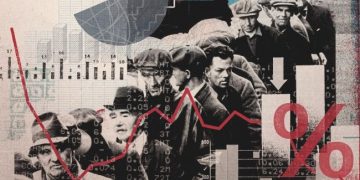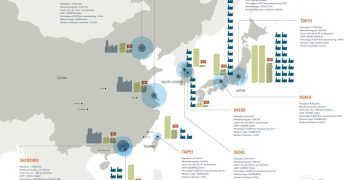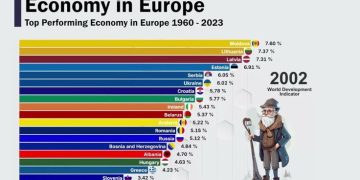[The Bank of Canada announced a rate cut of 25 basis points to 4.75%! Fired the “first shot” of G7 countries] On June 5, local time, the Bank of Canada announced the results of the latest interest rate discussion, reducing the benchmark interest rate by 25 basis points to 4.75%, which is the “first drop” of G7 countries. In addition, the European Central Bank will meet on June 6 local time, and the market expects the European Central Bank will probably cut interest rates before the Federal Reserve.
On June 5, local time, the Bank of Canada announced the latest round of interest rate results, cutting the benchmark interest rate by 25 basis points to 4.75%, the “first drop” for G7 countries.
In addition, the European Central Bank will meet on June 6 local time, and the market expects the European Central Bank will probably cut interest rates before the Federal Reserve.
The Bank of Canada cut interest rates

According to the results of the interest rate discussion, in addition to the reduction of the benchmark interest rate (overnight lending rate), the Bank of Canada also lowered the bank rate (BankRate) from 5.25% to 5%.
The Bank of Canada sees global economic growth of about 3 per cent in the first quarter of 2024, broadly in line with the Bank’s April Monetary Policy Report (MPR) forecast. In the United States, the economy expanded more slowly than expected as weak exports and inventories weighed on activity, and domestic private demand growth slowed but remained strong. In the euro area, economic activity picked up in the first quarter of 2024. China’s economy also performed strongly in the first quarter, buoyed by exports and industrial production. While progress towards price stability has been bumpy and uneven, inflation has continued to ease in most advanced economies.
In Canada, economic growth resumed in the first quarter of 2024 after stalling in the second half of last year. Canada’s first-quarter GDP growth came in at 1.7%, below MPR’s expectations. The Bank of Canada believes that weak inventory investment has held back economic activity, but consumption growth has been solid, and business investment and housing activity have also increased. And labor market data show businesses continue to hire, although employment is growing at a slower pace than the working-age population. While wage pressures remain, they appear to be easing. Overall, recent data suggest that the economy is still operating with oversupply.
The main consideration for the Bank of Canada’s monetary policy is that CPI inflation slowed further to 2.7% in April. The central bank’s preferred measure of core inflation has also moderated, with the three-month measure pointing to a continued decline in inflation momentum. Indicators of the extent of price increases among the components of the CPI fell further and were close to their historical averages. But it is worth noting that housing price inflation remains high.
With more evidence that inflation is easing, the Bank of Canada’s monetary policy Governing committee agreed that monetary policy no longer needed to be restrictive and cut the policy rate by 25 basis points. Recent data have bolstered the bank’s confidence that inflation will continue to move toward its 2 percent target. Nonetheless, risks to the inflation outlook remain. The Governing Council is closely monitoring the evolution of core inflation, with particular attention to the balance between supply and demand in the economy, inflation expectations, wage growth, and firm pricing behavior.

At a press conference after the release of the interest rate results, Bank of Canada Governor Tiffe McCollum (TiffMacklem) said that although inflation remains above the 2% target and housing price inflation remains high, the consumer price index (CPI) has continued to decline this year, and underlying inflation indicators are increasingly pointing to continued easing in the economy.
McCollum highlighted that the CPI fell to 2.7% in April from 3.4% in December; Core inflation has fallen from about 3.5 per cent in December to about 2.75 per cent in April. Core inflation has slowed below 2 per cent for the third straight month, from about 3.5 per cent in December.
McCollum believes these data all mean that restrictive monetary policy is easing price pressures. With further and more sustained evidence that inflation is easing, monetary policy no longer needs to be so restrictive. In other words, lower policy rates are appropriate.
If inflation continues to ease and confidence continues to grow that inflation is moving sustainably toward our 2 percent objective, it is reasonable to expect further reductions in our policy rate.
The Canadian dollar quickly retreated against the U.S. dollar after the Bank of Canada announced the rate cut. The dollar rose to C $1.3651 to 1.3710.
ECB: Rate cut on Thursday
This week, in addition to the Bank of Canada’s interest rate meeting, the European Central Bank will also meet. The European Central Bank is widely expected to cut interest rates.
In fact, compared with the gradual decline in Canadian inflation, the fall in eurozone inflation has not been smooth. Data showed eurozone inflation was slightly higher than expected in May, with headline inflation at 2.6% and core inflation at 2.9%. On top of that, the negotiated wage growth figure, which is closely watched by the ECB, accelerated again to 4.7% in the first quarter of this year after reaching 4.5% in the fourth quarter of 2023.
ECB board member Isabel Schnabel said: “We are seeing that some inflation factors are proving to be persistent – particularly in European countries, especially in the services sector. I would warn against moving too fast because there is a risk of cutting interest rates too quickly. We should definitely avoid that.”
“A lot of these numbers are distorted by one-off effects,” said HolgerSchmieding, chief economist at Berenberg Bank.
But while another rate cut in July cannot be ruled out, it seems unlikely given recent comments from ECB policymakers.
KathleenBrooks, an analyst with European brokerage XTB Group, said that while the ECB is expected to cut rates on Thursday, it could be seen as a hawkish cut as markets expect it to proceed cautiously with future rate cuts. In March, the ECB expected inflation to fall sharply over the next few years, however, inflation rose from 2.4 percent in April to 2.6 percent in May, indicating the opposite direction of price pressures from the ECB’s recent forecasts. In addition, wage growth is likely to continue since the eurozone unemployment rate fell to a record low of 6.5% in the first quarter, which means that the tightening of the eurozone labor market is likely to keep upward pressure on inflation. As a result, the ECB is likely to raise its inflation forecasts for this year and next. If so, the ECB rate cut pricing could change in the coming days and the euro would face upside risks.
































